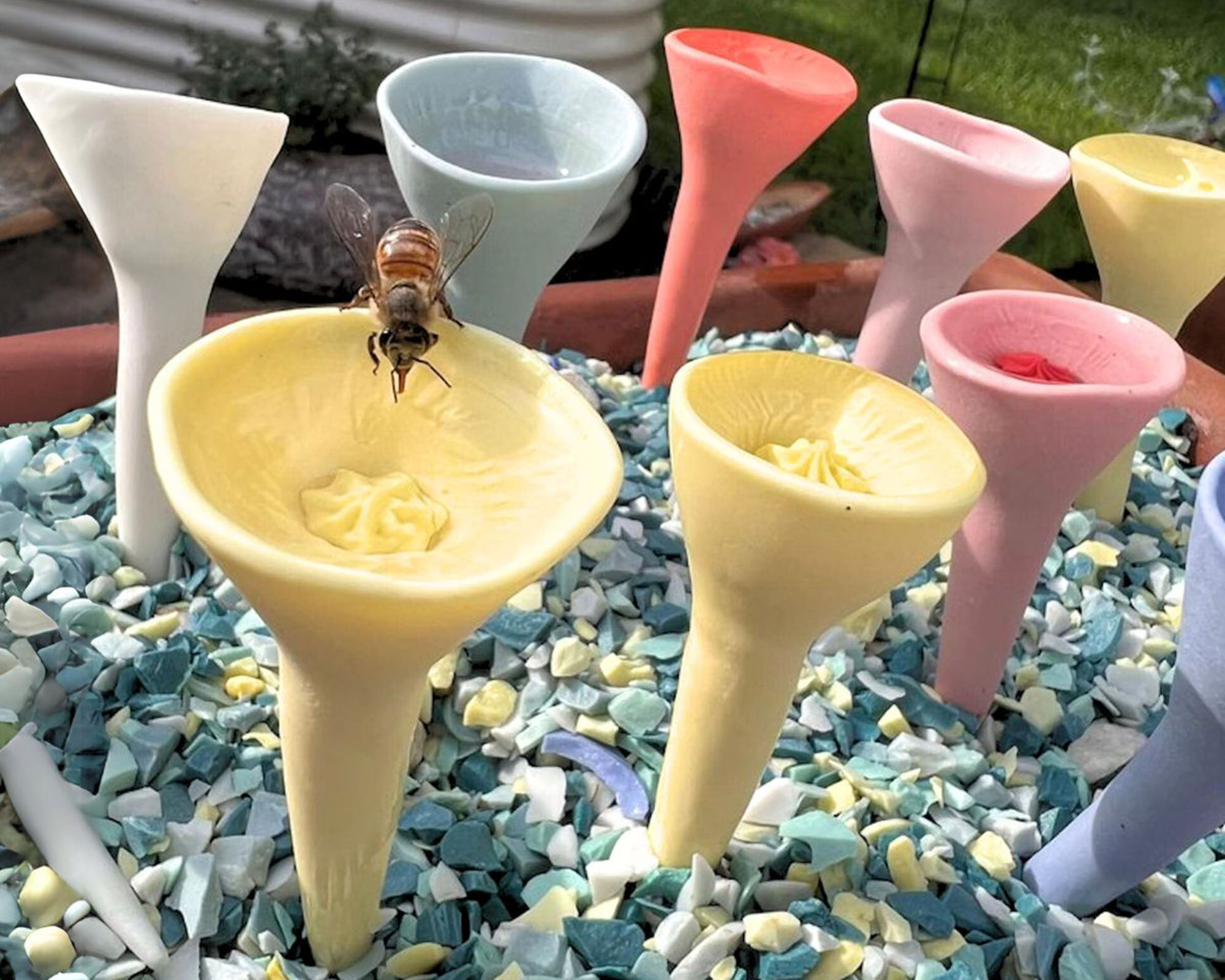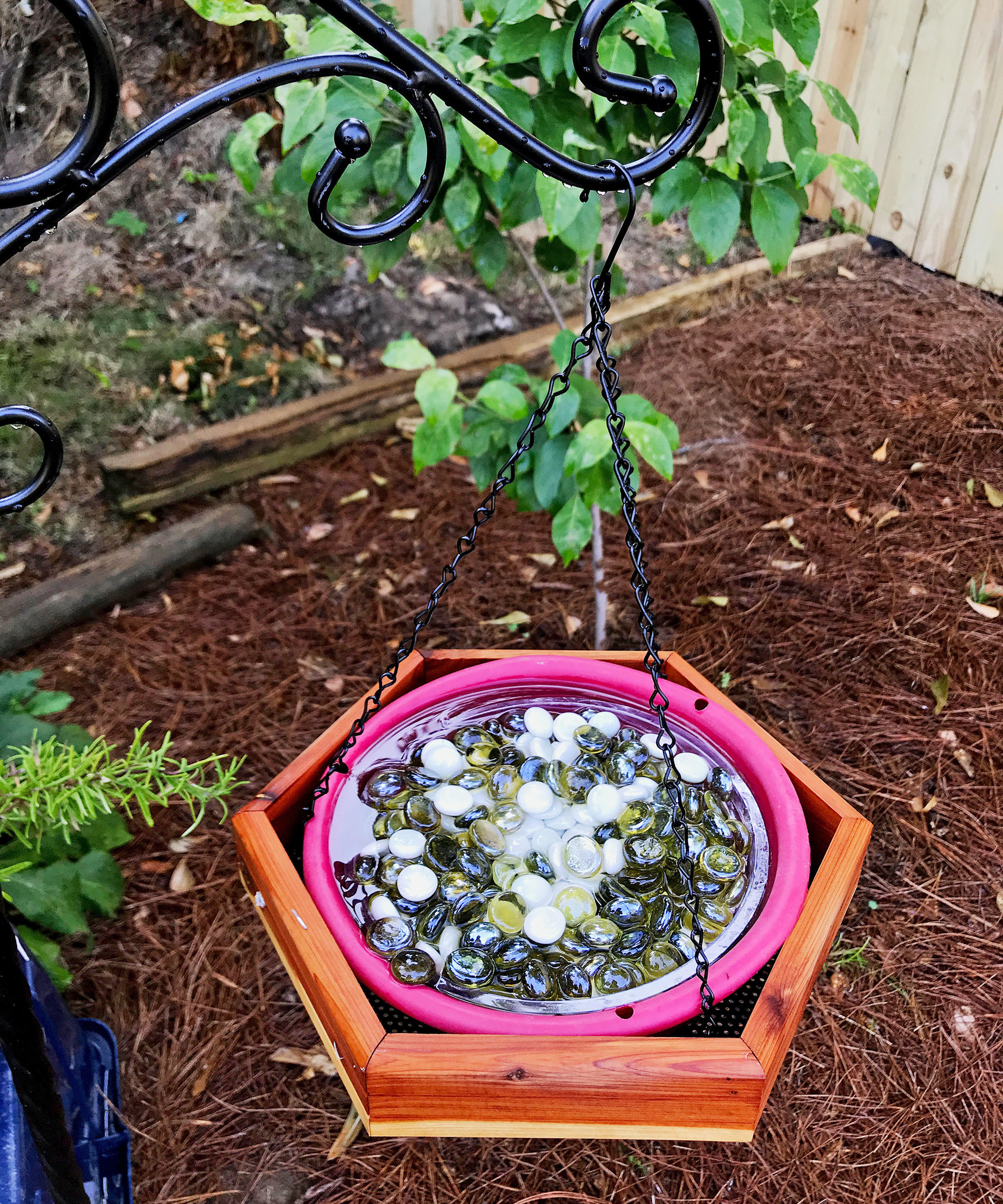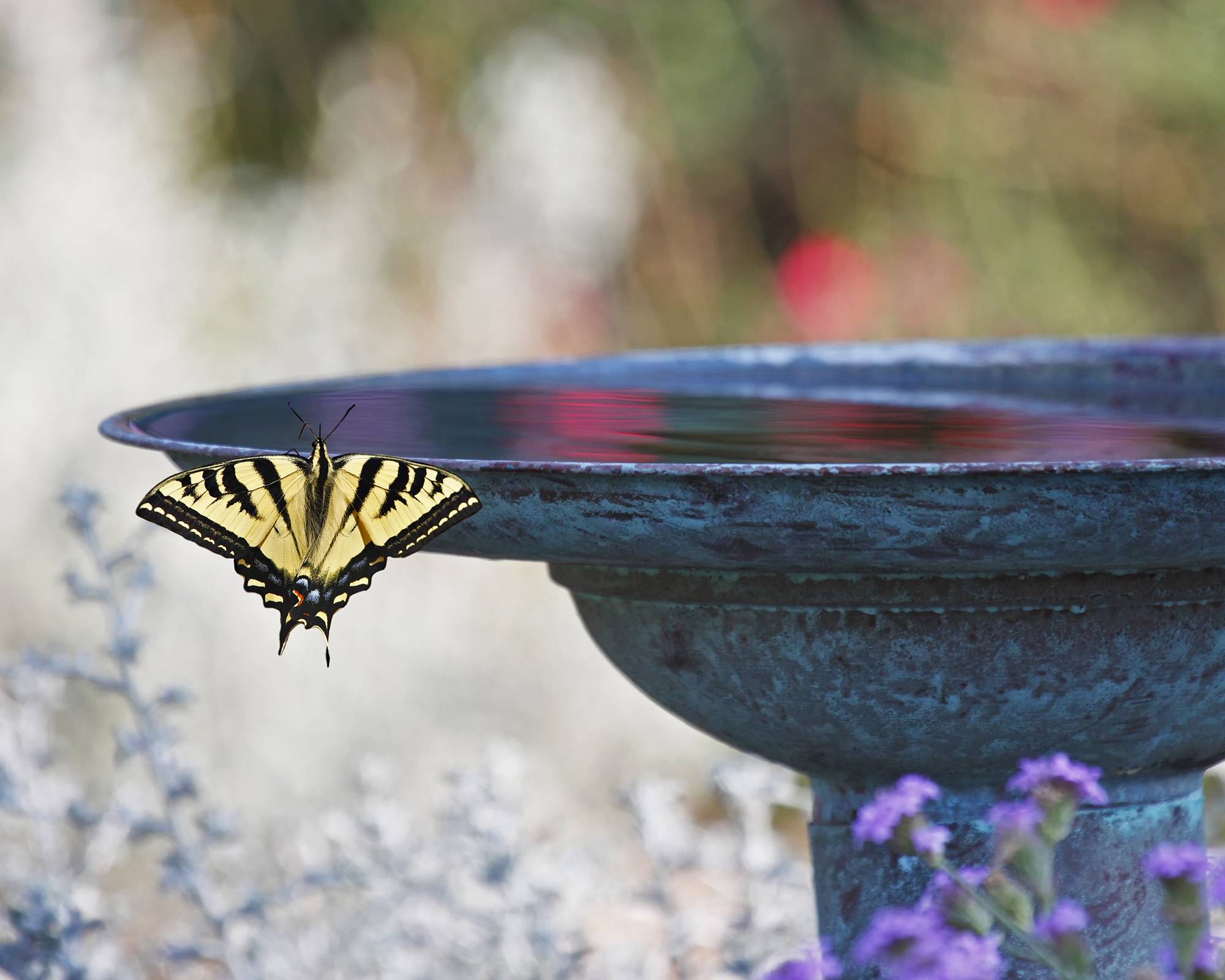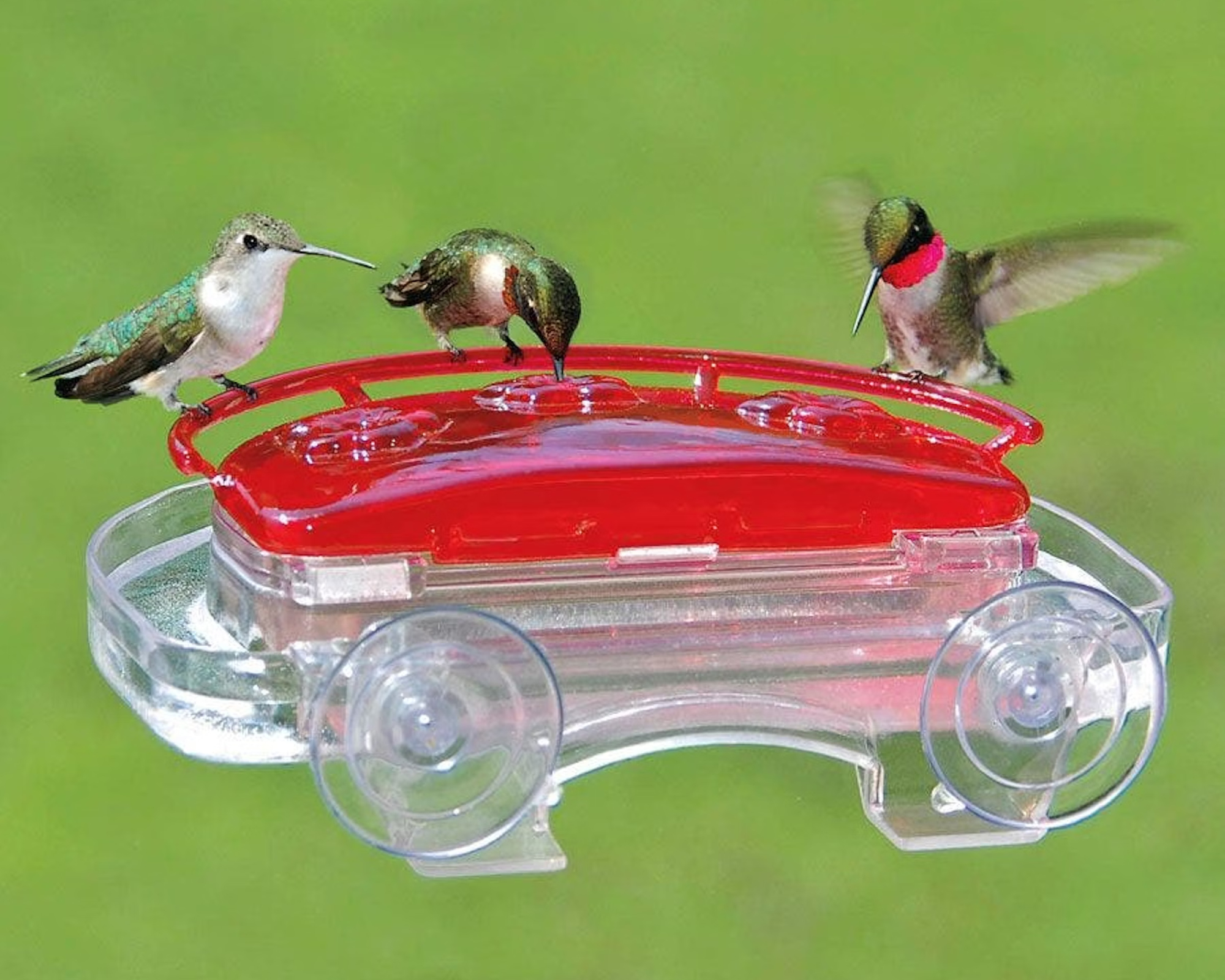5 Easy Pollinator Water Station Ideas That Give Bees, Butterflies & Hummingbirds A Lifeline
Bees, butterflies, hummingbirds, and other precious pollinators need to stay hydrated just like you do. Try adding a water station to help them thrive.


There’s so much that you do to support your region’s pollinating creatures. You plant pollinator-attracting annuals, perennials, and natives that give them food and nectar. You even provide materials they can use for nesting and shelter. There’s one more area, though, that many gardeners overlook. Pollinators need water.
Just as you reach for a glass of water during the day to quench your thirst, pollinating insects and birds need water to accompany their metabolic processes. This is especially so during hot summers and dry spells when water in puddles or dewdrops is scarce. We may assume that pollinators find their moisture through nectar, but nectar isn’t always available – nor does it contain all the moisture an insect or bird needs.
A pollinator water station can be that consistent source of much-needed water in your garden. Not only does it hydrate pollinators, but it also helps to support bee hives during the brood-rearing seasons when demand for water spikes. These stations also allow access to minerals needed by the pollinators. And hummingbirds sometimes use it for more than just water – they’ll bathe in it, too!
These miniature oases can be as simple or as fancy as you prefer. You can make one yourself out of a few simple items you have around the house, or you can purchase one specially designed for visiting pollinators – find these in our Pollinator Garden Shop, along with a range of other products and plants designed to support wildlife. Either way, they will become a hangout hot spot for the hard-working creatures in your garden.
What is a Pollinator Water Station?
Before we create or purchase a pollinator water station, we need to know what it is and how pollinators use it. In short, a pollinator water station is any device that provides clean water in an accessible way to a variety of pollinators, such as bees, butterflies, hummingbirds, moths, and other insects.
“In an accessible way” are key words here, as it helps to create a structure which is beneficial to the creature. Ideally, the water station is shallow or designed in some other way to prevent drowning, so these insects and birds can drink safely. Because of the difference in size between a hummingbird and a moth, for example, your garden may require two different types of watering stations.
Who uses this pollinator water station? Good question! The answer to that question depends on your location, as pollinators differ from region to region and also migrate. Generally speaking, your water station will be used by:
Sign up for the Gardening Know How newsletter today and receive a free copy of our e-book "How to Grow Delicious Tomatoes".
- Butterflies such as monarchs and swallowtails
- Moths such as the hawk moth and yucca moth
- Honeybees and native bees, such as the mason bee and the leafcutter bee
- Wasps and beetles, such as paper wasps and soldier beetles
- Hummingbirds such as the ruby-throated and black-chinned hummingbirds
Water Station Ideas
Think like a small creature when considering what water station device you’ll be using. Big pools of water are dangerous for these small creatures, as they might tip into the water and drown. A device that allows them a safe place to land is best. Here are a few examples of what you can use:
1. Bee Cups

These handmade porcelain creations by scientist-turned-ceramicist Jen Rose are designed with tiny pollinating creatures in mind – bees as well as butterflies, ladybugs, and also hummingbirds. Each Bee Cup has an inner bump that provides a safe place for pollinators to land. The porcelain is slightly textured, so bees don’t slip on the surface as they take a drink.
Jen applies a special ultraviolet glaze on each Cup that attracts a bee’s attention, mimicking the pattern bees can see in the center of flowers. These 100% chemical-free Bee Cups contain no plastics, will not fade with sun exposure and hold a safe amount of water. You can find Bee Cups in a variety of colors in the Gardening Know How Shop.
2. Shallow Dish

A shallow water-filled dish or plant saucer filled with marbles or pebbles is an easy, inexpensive way to provide a pollinator water station. The marbles or pebbles give pollinators a safe spot from where they can sip and rest. Place that dish or saucer atop an overturned plant pot and elevate the watering station to keep it away from crawling creatures.
3. Repurposed Bird Bath

Turn a bird bath into a watering station by filling it with pebbles or corks. The pebbles need to be large enough to provide a perch, while wine corks floating in a shallow vessel can act as a safety raft.
This Water Oasis Butterfly & Bird Bath from Wayfair is an ideal size and can be staked in the ground or mounted on a deck.
It's a good idea to include a separate bird bath just for birds, as while they will share a pollinator bath, they will avoid a spot with too many bees.
4. Automated Pet Waterer
Automate the water-filling process by using a waterer used for pet care. It's a good option if you don't have time to refill your pollinator watering station every day. This basic gravity-fed pet water dispenser from Amazon will do the trick. It holds a gallon of water, but be sure to add pebbles or corks to the dish to keep bees and butterflies afloat.
Alternatively, try this hanging bird water cooler, also available from Amazon, which automatically refills for a steady supply.
5. Hummingbird Feeder

A hummingbird feeder provides necessary energy for our busy winged pollinators. The Jewel Box Hummingbird Feeder in the Gardening Know How Shop has three ports from which to drink nectar and also a water-filled moat, which serves the dual purpose of providing water and blocking ants. Its suction cups mean it can be affixed to the window, so you can enjoy a clear view of the birds.
Placing & Maintaining the Water Station
As with any sort of real estate, location is key. Placing the pollinator water station in just the right spot will ensure the pollinators are making the most of this resource. For best results:
- Choose a sunny but sheltered spot
- Place it close to the flowers they will be visiting
- If using several water stations, spread them out around the gardens
- Keep it away from bird feeders where their predators may be perching
Clean the water station to keep your pollinators healthy. Empty and refill with fresh water every day to avoid attracting mosquitoes and to minimize any harmful bacteria. Clean the device entirely every few days, and even every day during the hottest part of the summer. Use a moderate brush and rinse with white vinegar. You’ll want to avoid using chemicals of any sort lest they harm the pollinators.
Insects require vitamins and minerals just as we do. While they rely on getting their nutrients from pollen and nutrient-rich soils, you might help them get their doses by providing these nutrients in the water stations. Do so by adding small amounts of sea salt, crushed seashells, or a small amount of soil to the watering stations. Alternatively, use Pollinade Tablets, available in the Gardening Know How Shop, which are loaded with essential salts and minerals.
Whether you go with simple pebbles in a saucer or invest in stylish Bee Cups, including a pollinator water station in your outdoor space is one of the simplest ways you can give back to nature.

Ellen Wells is a horticultural communications consultant with 30 years of experience writing about all aspects of the gardening world.
She has worked for many of horticulture’s biggest brand names, writing blog posts, articles, press releases, and design and instructional pieces. Her previous roles include Senior Editor and Editor-at-Large for Ball Publishing.
Ellen is based in New England where she gardens in Zone 7a. She loves tending to flower-filled containers on the patio and puttering around her vegetable garden.